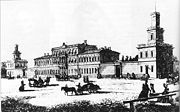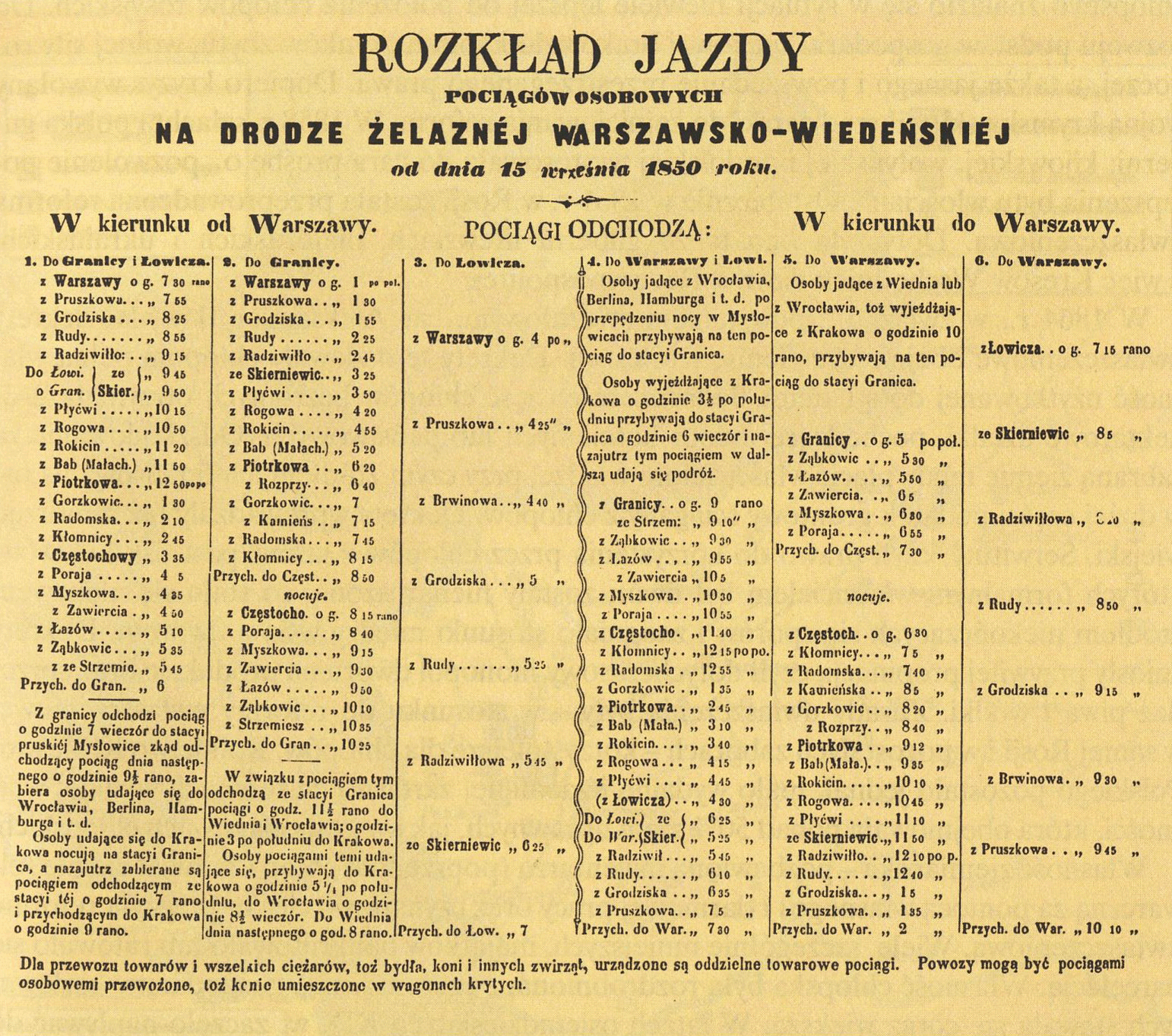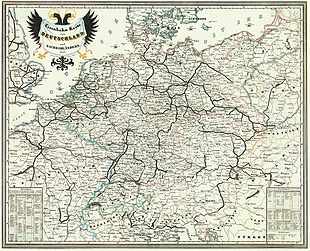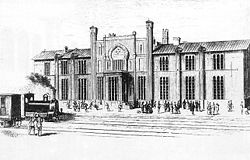
Warsaw-Vienna Railway
Encyclopedia


Congress Poland
The Kingdom of Poland , informally known as Congress Poland , created in 1815 by the Congress of Vienna, was a personal union of the Russian parcel of Poland with the Russian Empire...
, a part of the Russian Empire
Russian Empire
The Russian Empire was a state that existed from 1721 until the Russian Revolution of 1917. It was the successor to the Tsardom of Russia and the predecessor of the Soviet Union...
, from 1845 until 1912, when it was nationalized by the Russian government. The main component of its network was a line 327.6 km in length from Warsaw
Warsaw
Warsaw is the capital and largest city of Poland. It is located on the Vistula River, roughly from the Baltic Sea and from the Carpathian Mountains. Its population in 2010 was estimated at 1,716,855 residents with a greater metropolitan area of 2,631,902 residents, making Warsaw the 10th most...
to the Granica (English: Border) station (today Maczki, located in a suburb of Sosnowiec
Sosnowiec
Sosnowiec is a city in Zagłębie Dąbrowskie in southern Poland, near Katowice. It is one of the central districts of the Upper Silesian Metropolitan Union - a metropolis with a combined population of over two million people located in the Silesian Highlands, on the Brynica river .It is situated in...
) on the border with the Austrian Empire
Austrian Empire
The Austrian Empire was a modern era successor empire, which was centered on what is today's Austria and which officially lasted from 1804 to 1867. It was followed by the Empire of Austria-Hungary, whose proclamation was a diplomatic move that elevated Hungary's status within the Austrian Empire...
, from 1867 known as the Austro-Hungarian Empire. There the line reached the Austrian railway network, offering connections i.a. to Vienna
Vienna
Vienna is the capital and largest city of the Republic of Austria and one of the nine states of Austria. Vienna is Austria's primary city, with a population of about 1.723 million , and is by far the largest city in Austria, as well as its cultural, economic, and political centre...
(hence the name of the line). It was the first railway line built in Congress Poland
Congress Poland
The Kingdom of Poland , informally known as Congress Poland , created in 1815 by the Congress of Vienna, was a personal union of the Russian parcel of Poland with the Russian Empire...
and the second in the Russian Empire, after a short stretch of 27 km
Tsarskoye Selo Railway
The Tsarskoye Selo Railway was the first public railway line in the Russian Empire. It ran for from Saint Petersburg to Pavlovsk through the nearby Tsarskoye Selo. Construction began in May 1836, and the first test trips were carried out the same year between Tsarskoye Selo and Pavlovsk, using...
between Tsarskoye Selo
Tsarskoye Selo
Tsarskoye Selo is the town containing a former Russian residence of the imperial family and visiting nobility, located south from the center of St. Petersburg. It is now part of the town of Pushkin and of the World Heritage Site Saint Petersburg and Related Groups of Monuments.-History:In...
and Saint Petersburg
Saint Petersburg
Saint Petersburg is a city and a federal subject of Russia located on the Neva River at the head of the Gulf of Finland on the Baltic Sea...
which opened in 1837. The line used the standard European gauge
Standard gauge
The standard gauge is a widely-used track gauge . Approximately 60% of the world's existing railway lines are built to this gauge...
(1435 mm), as opposed to all other railways in the Russian Empire which used the broad gauge (1524 mm), hence it formed a system physically separated from other Russian railways.
Ownership

Congress Poland
The Kingdom of Poland , informally known as Congress Poland , created in 1815 by the Congress of Vienna, was a personal union of the Russian parcel of Poland with the Russian Empire...
was submitted to Bank Polski (Polish Bank) in January 1835. Three years later, in 1838 Towarzystwo Akcyjne Drogi Żelaznej Warszawsko-Wiedeńskiej (Warsaw-Vienna Rail Road Company Ltd) was established and granted a licence to build the railway.
Arguments between proponents of horse and steam traction lasted many years, and only in 1840 the latter was chosen when the building work started. The company went bankrupt in 1843 and was taken over by the state.
In 1857 the line was leased to a private company (also called Towarzystwo Akcyjne Drogi Żelaznej Warszawsko-Wiedeńskiej) for 75 years, however it was re-nationalised in 1912, with a compensation paid to the shareholders (mostly Belgians and Germans).
Permanent way
The first stretch of the line, from Warsaw to Grodzisk Mazowiecki (30 km), opened on 14 June 1845, and got extended to Skierniewice with a branch to Łowicz on 15 October 1845. The trains reached Częstochowa in 1846, Ząbkowice in 1847 and the Austrian border on 1 April 1848. There were 27 station on the line.Initially the line was single, but from the beginning the earthwork was done in preparation for the second track, which was gradually added to the whole route between 1872 and 1881.
The termainal border station lay close to Szczakowa
Szczakowa
Szczakowa is a district of the Polish city of Jaworzno. Located in historical Lesser Poland, it now belongs to the Silesian Voivodeship and is one of the most important rail hubs of the area. In the years 1933-1956, it was a separate town....
Station of the Kraków and Upper Silesia railway (Kolej Krakowsko-Górnośląska / Krakau-Oberschlesische Bahn), This line indirectly by the two Prussian lines of Upper Silesian Railway (Oberschlesische Bahn) and William's Railway (Wilhelmsbahn) was joined to the Austrian Northern Railway
Northern Railway (Austria)
The Emperor Ferdinand Northern Railway was the name of a former railway company during the time of the Austro-Hungarian monarchy. Its main line was supposed to connect Vienna with salt mines in Bochnia near Kraków...
(in Bohumin
Bohumín
Bohumín is a town in Karviná District, Moravian-Silesian Region, Czech Republic on the border with Poland. The confluence of the Oder and Olza Rivers is situated just north of the town. The town lies in the historical region of Cieszyn Silesia....
), which reached the Prussian border from Vienna. A perfectly Austrian communication was not available, before in 1856 the Austrian Eastern National Railway, descendant of the Krákow and Upper Silesia Railway, closed the gap with a branch form Trzebinia
Trzebinia
Trzebinia is a town in Chrzanów County, Lesser Poland, Poland with an Orlen oil refinery and a major rail junction of the Kraków - Katowice line that connections to Oświęcim and Spytkowice.-History:...
to Dziedzice
Dziedzice
Dziedzice may refer to the following places:* Dziedzice, Greater Poland Voivodeship * Dziedzice, Masovian Voivodeship * Dziedzice, Krapkowice County in Opole Voivodeship...
.
Stations

- The Warsaw terminus (Vienna Station), designed by Enrico MarconiEnrico MarconiEnrico Marconi, known in Poland as Henryk Marconi , was an Italian architect who spent most of his life in Congress Poland....
, opened in 1845 and remained in use for over 75 years. The building, facing Aleje JerozolimskieAleje JerozolimskieAleje Jerozolimskie is one of the principal streets of the city of Warsaw in Poland. It runs through the City Centre along the East-West axis, linking the western borough of Wola with the bridge on the Vistula River and the borough of Praga on the other side of the river.The name of the street...
, was 166 metres long and 18 metres wide, with the three storey central part, flanked by two 25 metre towers. The western tower housed an optical telegraph station on the top floor, the eastern one had a clock. - Marconi designed also the southern terminus of the line, in Granica, on a much more modest scale.
Rolling stock

August Borsig
Johann Friedrich August Borsig was a German businessman who founded the Borsig-Werke factory.Borsig was born in Breslau , the son of cuirassier and carpenter foreman Johann George Borsig...
and other West European factories. From 1901 locomotives were Russian-built, but different from common Russian stock.
Route
Main line:Warszawa - Grodzisk Mazowiecki
Grodzisk Mazowiecki
Grodzisk Mazowiecki is a town in central Poland with 26,881 inhabitants in 2006. It is 30 km. southwest of Warsaw.Between 1975 and 1998 it was situated in the Warszawa Voivodeship but since 1999 it has been situated in the Masovian Voivodeship. It is the capital of Grodzisk Mazowiecki...
- Skierniewice
Skierniewice
Skierniewice is a town in central Poland with 49,132 inhabitants , situated in the Łódź Voivodship , previously capital of Skierniewice Voivodship . It is the capital of Skierniewice County. The town is situated almost exactly half-way between Łódź and Warsaw.Skierniewice gained municipal rights...
- Koluszki
Koluszki
Koluszki is a town, and a major railway junction, in Central Poland, in Łódź Voivodeship, about 20 km east of Łódź. Population: 13,331 . The junction in Koluszki serves trains that go from Warsaw to Łódź , Wrocław, Częstochowa and Katowice. Also, it is connected with Radom and Lublin by an...
- Piotrków Trybunalski
Piotrków Trybunalski
Piotrków Trybunalski is a city in central Poland with 80,738 inhabitants . It is situated in the Łódź Voivodeship , and previously was the capital of Piotrków Voivodeship...
- Radomsko
Radomsko
Radomsko is a town in central Poland with 50,618 inhabitants . It is situated on the Radomka river in the Łódź Voivodeship , having previously been in Piotrków Trybunalski Voivodeship . It is the capital of Radomsko County....
- Częstochowa
Czestochowa
Częstochowa is a city in south Poland on the Warta River with 240,027 inhabitants . It has been situated in the Silesian Voivodeship since 1999, and was previously the capital of Częstochowa Voivodeship...
- Zawiercie
Zawiercie
Zawiercie is a city in the Silesian Voivodeship of southern Poland with 55,800 inhabitants . It is situated in the Kraków-Częstochowa highland near the source of the Warta River...
- Ząbkowice Będzińskie - Strzemieszyce Południowe - Granica (border with Austria)
Branch lines:
- Skierniewice - Łowicz
- Ząbkowice - SosnowiecSosnowiecSosnowiec is a city in Zagłębie Dąbrowskie in southern Poland, near Katowice. It is one of the central districts of the Upper Silesian Metropolitan Union - a metropolis with a combined population of over two million people located in the Silesian Highlands, on the Brynica river .It is situated in...
- KoluszkiKoluszkiKoluszki is a town, and a major railway junction, in Central Poland, in Łódź Voivodeship, about 20 km east of Łódź. Population: 13,331 . The junction in Koluszki serves trains that go from Warsaw to Łódź , Wrocław, Częstochowa and Katowice. Also, it is connected with Radom and Lublin by an...
- Łódź-Fabryczna

